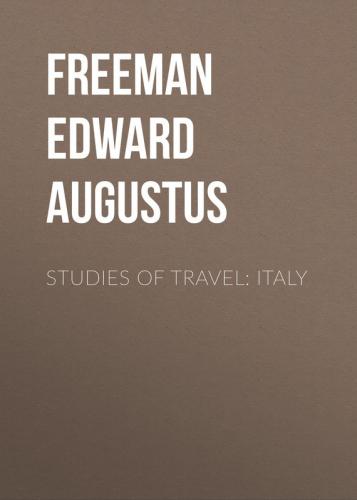The site of Veii is that of a great city, a strong city, but not a city made, like Rome, for rule. We go far and wide, and we find nothing like the "great group of village communities by the Tiber." Veii is not a group, and she has no Tiber. The city stood high on the rocks, yet it can hardly be called a hill-city. A peninsular site rises above the steep and craggy banks of two small streams which make up the fateful Cremera; but the peninsula itself is nearly a table-land, a table-land surrounded by hills. The stream supplied the walls with an admirable natural fosse, and that was all. The vast space enclosed by the walls makes us naturally ask whether the city could have been laid out on so great a scale from the beginning. We may believe that, as in so many cases, the arx, a peninsula within a peninsula, was the original city, and that the rest was taken in afterwards. But, if so, it would seem as if it must have been taken in at a blow, as if Veii took a single leap from littleness to greatness, unlike the gradual growth of Rome or Syracuse. At all events, there is the undoubted extent of a great city, a city clearly of an earlier type than Rome, a city which may well have reached its present extent while Rome had not spread beyond the Palatine. Such a site marks a great advance on the occupation of inaccessible hill-tops; but Veii itself must have seemed an old-world city in the eyes of those who had the highway of the Tiber below their walls.
It is strange to step out the traces of a city whose position and extent are so unmistakably marked, but of which nothing is left which can be called a building, or even a ruin. The most memorable work in the circuit of Veii is a work not of building but of boring – the Ponte Sodo, hewn in the rock for the better passage of the guardian stream. Besides these, some small fragments of the Etruscan wall, the signs of a double gate, some masonry of the small Roman tower which in after times arose within the forsaken walls, are pretty well all that remains of the life of Veii. The remains of its death are more plentiful. There is the Roman columbarium, within the Etruscan site; there are the Etruscan tombs bored deep in all the surrounding hills. There is, above all, the famous painted tomb, shielding no such sculptures and inscriptions as those on which we gaze in the great Volumnian sepulchre, but within which one lucky eye was privileged for a moment to see the Lucumo himself, as he crumbled away at the entrance of the unaccustomed air. A scrap or two of his harness is there still; the arms are there; the strange-shaped beasts are there, in their primitive form and colouring; the guardian lions keep the door; but we have no written ænigma even to guess at. We can only feel our way to a date by marking the imperfect attempt at an arch, an earlier and ruder stage by far than the roof of Rome's Tullianum or its fellow at Tusculum. In the Volumnian tomb the main interest comes from the fact that it belongs to the very latest Etruscan times, to the transition from Etruscan to Roman life. In the Veientine tomb the main interest comes from the fact that it cannot be later than an early stage in Roman history, and that it may be as much earlier as we choose to think it. It is the same with all the little that is left of Veii. We know that, except the palpable remains of the Roman municipium, nothing can be later than B.C. 396, and that anything may be vastly earlier. In the history of Italy, the date when Rome doubled her territory by conquering a city a dozen miles from her gates passes for an early stage. The life of Rome is still before her. In Greece at the same date, the greatness of Athens, the truest greatness of Sparta, is past; the only fresh life that is to come is that of ephemeral Thebes and half-Hellenic Macedonia.
Конец ознакомительного фрагмента.
Текст предоставлен ООО «ЛитРес».
Прочитайте эту книгу целиком, купив полную легальную версию на ЛитРес.
Безопасно оплатить книгу можно банковской картой Visa, MasterCard, Maestro, со счета мобильного телефона, с платежного терминала, в салоне МТС или Связной, через PayPal, WebMoney, Яндекс.Деньги, QIWI Кошелек, бонусными картами или другим удобным Вам способом.
